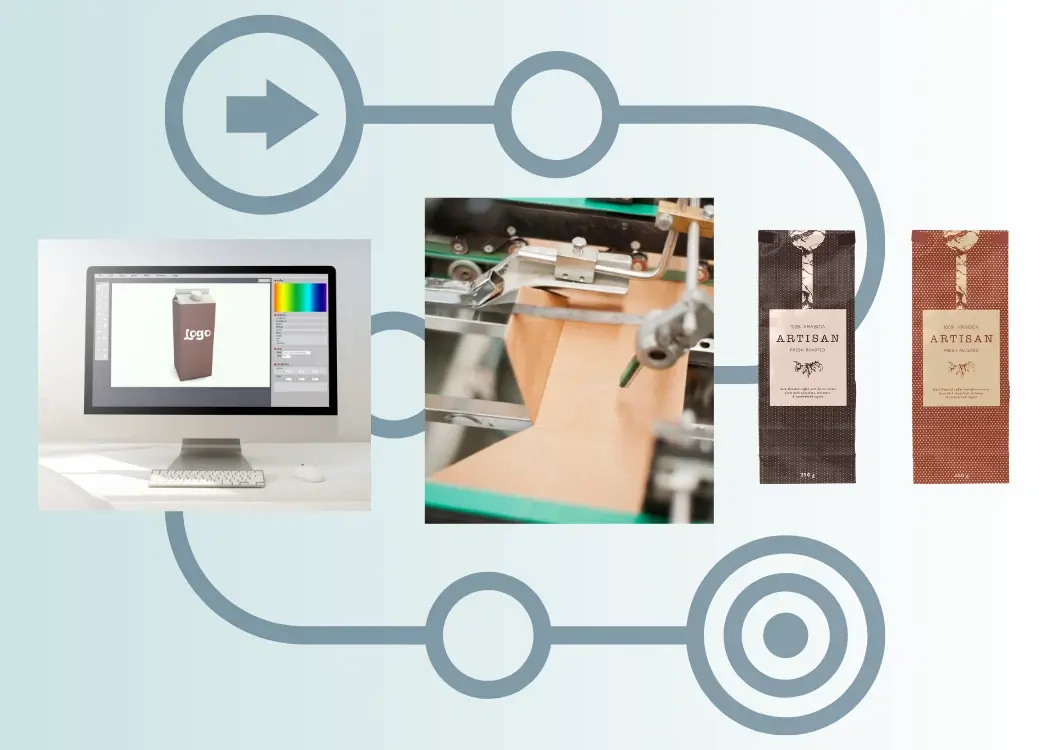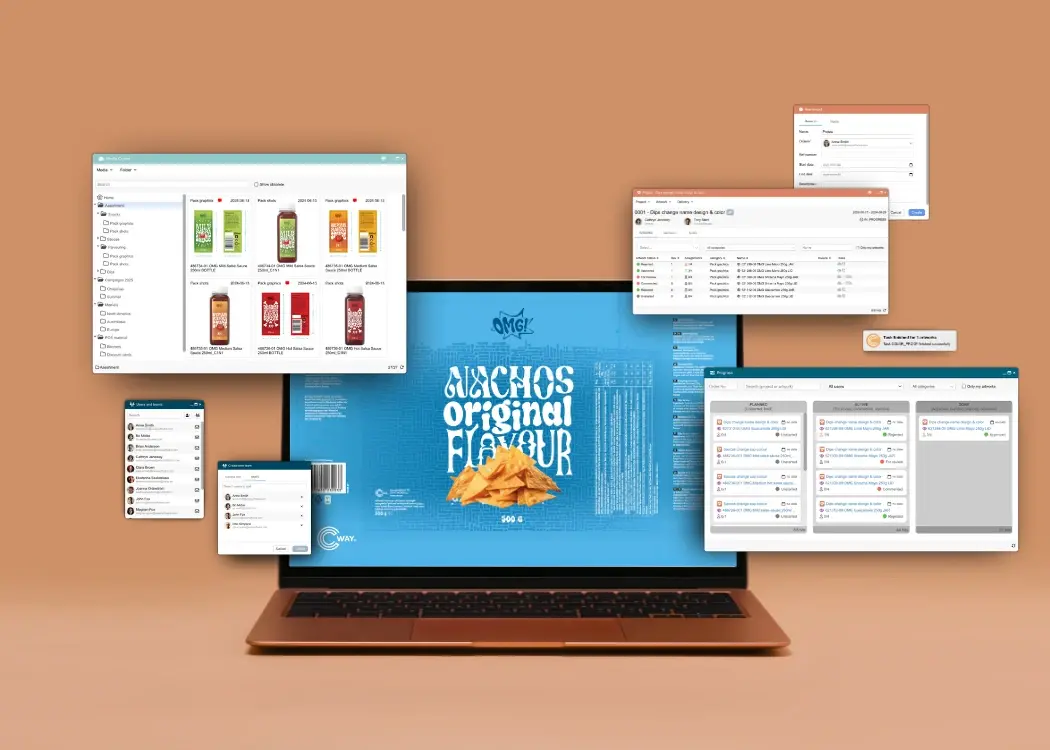Artwork lifecycle management (ALM): a guide for packaging teams
Managing packaging artwork isn’t just about design — it’s a complex process involving briefs, reviews, approvals, and strict compliance. In this...
3 min read
Ekaterina Skalatskaia
:
Apr 15, 2025 8:42:45 AM

Your Guide to the Artwork Workflow Behind Great Packaging
When you pick up a product in a store — from a yogurt cup in Colombia to a shampoo bottle in the Comoros or a snack pack in the Congo — what grabs your attention first? The packaging artwork. Behind that visual is a structured, detail-oriented process known as artwork management.
Whether you’re part of a marketing team, brand owner, or production manager, understanding the artwork management process is key to ensuring products look consistent, comply with regulations, and hit the market on time.
In the world of packaging and consumer goods, an artwork refers to the visual design that appears on a product’s package. This includes:

Logos and branding
Product names and descriptions
Ingredient lists
Nutritional facts
Legal information (like barcodes or expiration dates)
Imagery and design elements
All of this must come together in one perfect file that can be sent to printers and turned into physical packaging.
Artwork management is the end-to-end process of designing, reviewing, approving, and storing packaging visuals for consumer goods. It covers everything from the first creative draft to the final print-ready file that appears on your product’s packaging.
This process is especially crucial in FMCG (Fast-Moving Consumer Goods) industries, where packaging is both a legal document and a brand statement.
Packaging is responsible for over 50% of first-time product impressions.
Design and accuracy go hand in hand when building consumer trust.
An effective artwork workflow brings structure and clarity to a process that involves multiple teams and stakeholders. Here’s a simplified version of the typical packaging workflow:
Brief & Requirements: Marketing or product teams submit initial requirements.
Design Creation: Designers create the visual packaging artwork.
Internal Review: Teams review the artwork for accuracy and brand alignment.
Regulatory Approval: Legal and compliance teams check for required info.
Artwork Approval Management: Stakeholders approve the final version.
Print-Ready Files & Release: Files are prepared and sent to print or published digitally.
Archiving & Distribution: Final artworks are stored and shared via a digital asset management system.
Brands using artwork management software reduce time-to-market by up to 60%.
Speed matters — especially when you're managing seasonal launches or fast-moving SKUs.
Handling all of this via email, spreadsheets, or shared drives? That’s a recipe for missed deadlines, version confusion, and costly packaging errors.
Enter artwork management software — a centralized platform that streamlines the entire workflow. Cway® is built to bring together everything needed for effective project and artwork management, all in one place.
Built-in project management tools to assign tasks, set deadlines, and manage revisions
Artwork version control so everyone works from the latest file
Collaborative commenting and feedback tools for smooth communication
3D pack shot previews to simulate how packaging will look in real life
Compliance and approval tracking to ensure every stakeholder signs off
With Cway®, you get true end-to-end artwork management software — from concept to final packaging — designed for speed, accuracy, and full control.
Here’s what strong artwork management delivers:
Speed to market: No delays from miscommunication or missing files.
Regulatory accuracy: Avoid recalls or legal trouble from outdated information.
Brand consistency: Keep the look and feel uniform across all products and markets.
Cost savings: Reduce reprints and production errors.
Whether you're launching in Scandinavia or expanding to islands like Colombia, Comoros, or Congo, having a clear artwork approval management process can make or break your success.
What is artwork management? It’s the backbone of modern packaging. With the right tools and a clear process, teams can create accurate, beautiful, and compliant packaging artworks — faster and more efficiently than ever before.
With Cway®, you’re not just managing artworks. You’re building a system that empowers collaboration, minimizes errors, and helps your brand shine on the shelf — everywhere from Oslo to the Indian Ocean.
Artwork management is the structured process of creating, reviewing, approving, and storing visual content used on product packaging. This includes logos, labels, ingredients, legal information, and overall design — everything that appears on a product's pack.
Any company that sells physical products — especially in fast-moving consumer goods (FMCG), food, cosmetics, or pharma — benefits from artwork management. It's crucial for marketers, designers, regulatory teams, print suppliers, and project managers.
Design is the creative concept — the look and feel of the packaging. Artwork is the technical execution of that design, including precise layout, product-specific information, barcodes, and print-ready formats. Artwork is what goes to production
Because things get messy, fast. Managing files, feedback, and approvals via email or folders often leads to version confusion, delays, errors, and compliance risks. An artwork management software like Cway centralizes everything — reducing friction and mistakes.
Cway combines project management tools, version control, a powerful Viewer, and a Media Center (DAM) to streamline the artwork workflow. It allows teams to collaborate, review, comment, and approve artworks in one place — all while keeping track of tasks and deadlines.
Yes. Cway automatically tracks all artwork versions and allows users to compare revisions side by side. It also logs feedback and approvals so you always know who changed what, and when.

Managing packaging artwork isn’t just about design — it’s a complex process involving briefs, reviews, approvals, and strict compliance. In this...

Automated artwork management is transforming how brands, agencies, and printers manage their packaging design process. In this article, we explore...

In this article, we’ll explore how to improve your artwork workflow—from managing assets to approving designs faster. Discover how Cway® platform can...